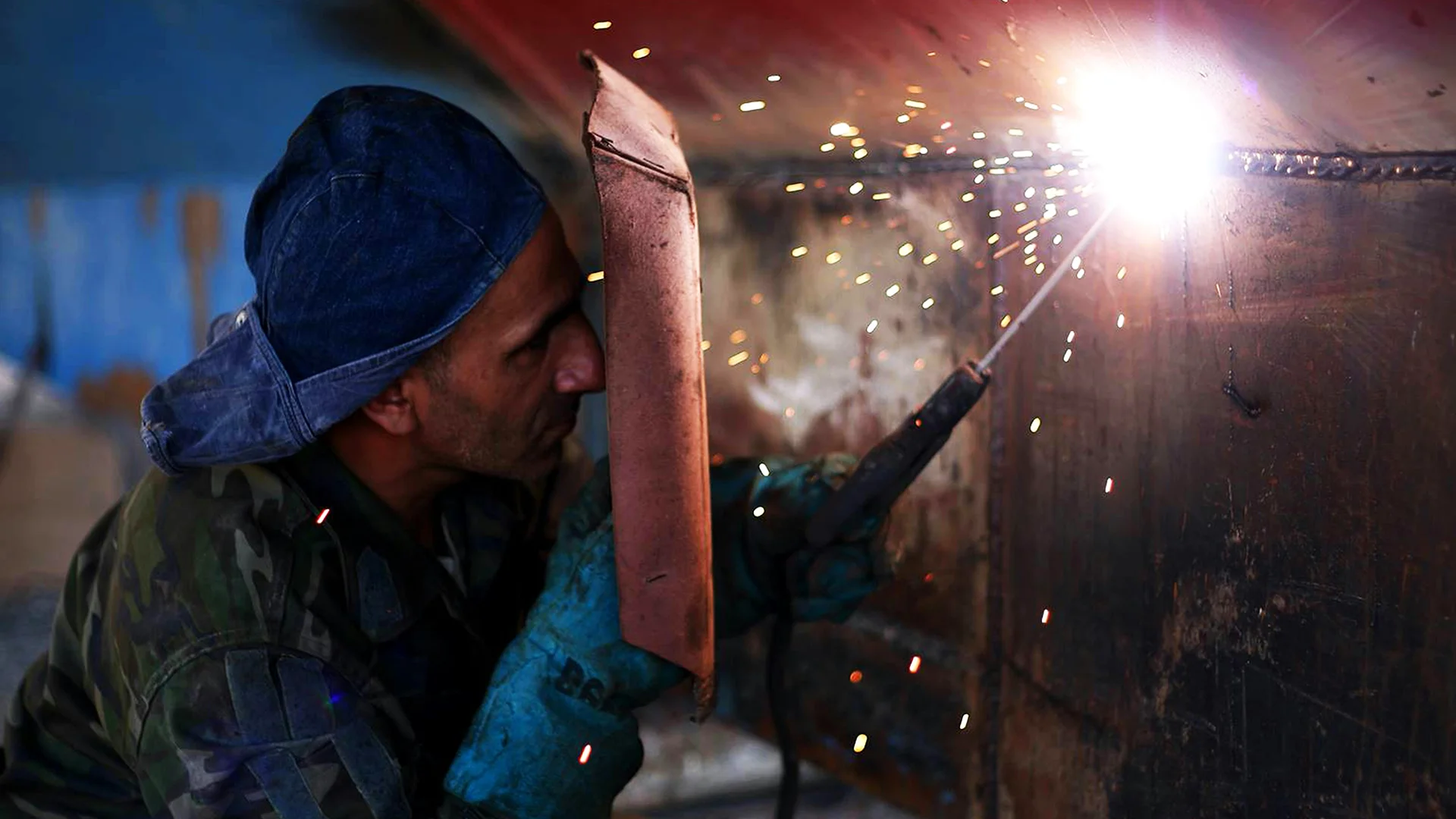Trade Counter Open Monday to Friday, 8.30am-5pm
What is Arc Eye and Why is it Dangerous?

Have you ever experienced a sudden burning sensation in your eyes after working with bright lights or welding equipment?
This could be more than just temporary discomfort.
Arc eye is a condition that affects many people exposed to intense light sources, often without them realising the risks.
Left unprotected, your eyes can suffer serious consequences.
But what exactly is arc eye, and why is it a concern?
In this article, we’ll explore the condition, its causes, and what makes it so dangerous.
What is Arc Eye?

Arc eye is a type of eye injury caused by exposure to high-intensity UV light.
This condition affects the cornea, which is the transparent layer at the front of the eye.
When the cornea is exposed to excessive UV rays, it becomes inflamed and irritated.
Arc eye is similar to sunburn, but instead of affecting the skin, it impacts the eye's surface.
It is most commonly experienced by welders who do not use proper eye protection.
This condition is usually temporary, but the symptoms can be very painful.
In severe cases, repeated exposure can cause long-term eye damage.
What Causes Arc Eye?

Arc eye occurs when the cornea, the clear front part of the eye, is exposed to intense ultraviolet (UV) light.
This overexposure leads to inflammation and damage, much like sunburn on the skin. Several factors can cause arc eye, including the following:
Welding and Cutting Equipment
The most common cause of arc eye is exposure to welding arcs.
The bright UV light produced during welding, cutting, or grinding can harm the eyes if proper protective gear is not used.
Even a short exposure can lead to symptoms.
Sunlight and Reflections
Prolonged exposure to strong sunlight, especially when reflected off surfaces like snow, water, or sand, can cause a similar effect.
This condition is sometimes called snow blindness.
UV Lamps and Lasers
UV lamps, tanning beds, and industrial lasers emit strong UV radiation.
Direct exposure to these without protective eyewear can damage the cornea.
High-Intensity Lighting
Bright halogen or LED lights used in construction, photography, or stage lighting can also contribute to arc eye if viewed directly for extended periods.
Why is Arc Eye Dangerous?
Arc eye is more than just a minor irritation.
If left untreated, it can cause severe discomfort and lead to complications that affect vision and eye health.
Below are some key reasons why arc eye is dangerous.
Intense Pain and Discomfort
Arc eye causes a painful burning sensation in the eyes.
The cornea, which is highly sensitive, becomes inflamed, making even blinking uncomfortable.
The pain can be so intense that it disrupts daily activities and sleep.
Temporary Vision Impairment
Blurred vision and excessive tearing are common symptoms of arc eye.
These effects can make it difficult to see clearly, increasing the risk of accidents, especially in work environments that involve machinery or hazardous conditions.
Increased Risk of Infection
Damaged corneal cells leave the eye vulnerable to bacterial infections.
If bacteria enter the injured cornea, conditions such as keratitis can develop, potentially leading to permanent vision problems if not treated quickly.
Long-Term Eye Damage
Repeated exposure to UV radiation without protection can cause long-term damage.
Over time, this increases the risk of cataracts, macular degeneration, and other vision-related issues.
What are the Symptoms of Arc Eye?
Arc eye symptoms usually appear a few hours after UV exposure and can worsen over time.
The condition affects the cornea, leading to pain and discomfort.
Below are the most common symptoms.
Eye Pain and Irritation
One of the first signs of arc eye is a burning or gritty sensation, as if sand is trapped in the eye.
The pain can range from mild discomfort to severe aching that makes it difficult to keep the eyes open.
Redness and Swelling
The eyes may become red and inflamed due to corneal irritation.
Swelling of the eyelids can also occur, making it uncomfortable to blink.
Excessive Tearing and Watery Eyes
The body reacts to corneal damage by producing more tears.
This can cause constant watering of the eyes, making vision blurry.
Light Sensitivity (Photophobia)
Bright lights can become unbearable, forcing individuals to keep their eyes closed or stay in dark environments.
Blurred Vision and Temporary Vision Loss
Blurry vision is common, and in severe cases, some may experience temporary vision loss.
While this usually resolves as the cornea heals, it can be distressing.
How is Arc Eye Treated?

Arc eye usually heals on its own within a day or two, but treatment can help relieve pain and speed up recovery.
Below are the most effective ways to manage the condition.
Resting the Eyes
The best way to recover is to give your eyes time to heal.
Avoid bright lights and screen exposure, and keep your eyes closed as much as possible.
Cold Compresses
Applying a cold compress or damp cloth over closed eyelids can reduce swelling and ease discomfort.
Lubricating Eye Drops
Artificial tears or lubricating eye drops help soothe irritation and keep the eyes moist.
Pain Relief Medication
Over-the-counter painkillers like ibuprofen or paracetamol can help manage pain and reduce inflammation.
Antibiotic Eye Drops or Ointments
In some cases, doctors may prescribe antibiotic drops or ointments to prevent infection while the cornea heals.
Avoiding Further UV Exposure
Staying away from bright light and wearing sunglasses can prevent symptoms from worsening.
How Long Does Arc Eye Last?
Arc eye is usually a temporary condition.
Most cases improve within 24 to 48 hours as the cornea heals itself.
Mild cases may resolve within a day, while more severe irritation could take up to three days to fully clear.
During this period, symptoms like pain, redness, and light sensitivity gradually ease.
Proper care, such as using lubricating eye drops, resting the eyes, and avoiding further UV exposure, can speed up recovery.
In rare cases, if the damage is more severe or the eyes become infected, healing may take longer.
If symptoms persist beyond 48 hours, worsen, or include vision changes, seeking medical advice is crucial.
To prevent delays in healing, avoid rubbing your eyes and stay in a dimly lit environment.
With the right care, most people recover quickly and without long-term complications.
How Can You Protect Yourself from Arc Eye?

Preventing arc eye is crucial for anyone exposed to intense UV light.
The following precautions can help protect the eyes:
Wear Proper Eye Protection
The best way to prevent arc eye is by wearing appropriate eye protection.
Welders should use welding helmets with the correct shade filter to block harmful UV rays.
Safety goggles with UV-resistant lenses are essential for those working near welding areas.
Use Safety Screens and Barriers
If you are near someone welding, stand behind a welding screen or curtain.
These barriers block intense UV light and reduce exposure.
Avoid Direct Exposure
Never look directly at a welding arc without protection.
Even a brief glance can cause damage.
If you must be in the area, ensure your eyes are shielded.
Wear Sunglasses with UV Protection
If working outdoors, choose high-quality sunglasses that block 100% of UV rays.
This helps reduce exposure from reflections.
Encourage Safe Workplace Practices
Employers should enforce safety rules, ensuring all workers use proper eye protection and welding screens.
Training sessions can help workers understand the risks and prevention methods.
Conclusion
You should now have an understanding of exactly what arc eye is and why it’s dangerous.
Arc eye is a painful yet preventable condition caused by exposure to intense UV light.
It primarily affects welders but can also occur in other high-UV environments.
While symptoms are usually temporary, repeated exposure can lead to long-term eye damage.
Recognising the symptoms of arc eye and knowing how to treat it can help ensure a quick recovery.
More importantly, taking proper precautions - such as wearing protective eyewear and limiting exposure - can prevent the condition entirely.
If you work in an environment with high UV exposure, prioritising eye safety is essential.
Protect your vision today to prevent painful and potentially harmful eye conditions in the future.
For more information, or help with your welding needs, get in contact with us here at Xtreme Plasma today.
Powered by Lightspeed
Display prices in:GBP
